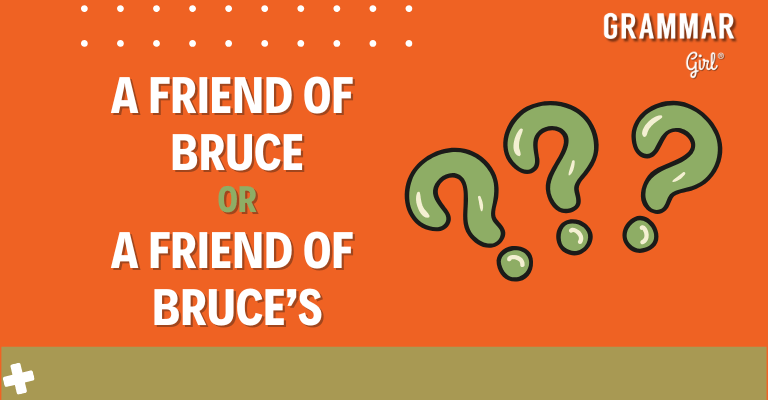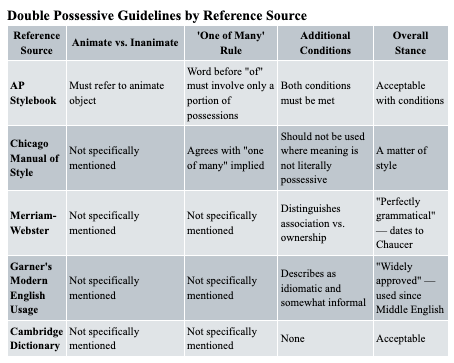The question of double possessives is complex, or at least it seems that way. Phil from North Carolina recently submitted this question:
“If Harry is Bruce’s friend, is it correct to say ‘he is a friend of Bruce,’ as opposed to ‘[he is] a friend of Bruce’s’? The former doesn’t sound quite right, possibly because of the common usage of the alternative, [which] seems to be a ‘double possessive.'” Phil is correct on both counts. “A friend of Bruce” sounds awkward to some people. And the commonly used “a friend of Bruce’s” is a double possessive and is perfectly “legal.” Let’s break this down a little more and see what the most prevalent style guides have to say.
Of course, the normal way to form possessives in English is either with an apostrophe “s” or with the word “of.” The example we gave years ago in episode 449 is “the U.K.‘s Crown Jewels” or “the Crown Jewels of the U.K.” Both are grammatical.
But what if we use a double possessive? Is it “the Grammar Girl podcast of Mignon” or “the Grammar Girl podcast of Mignon‘s” (with an apostrophe “s”)? Most native speakers of English would probably say the second one sounds more natural, even though some language purists will tell you it’s ungrammatical. Well, it’s not! It’s perfectly acceptable, and sometimes useful and even necessary.
First, most of the major style guides agree that double possessives are okay, but – there’s always a “but,” isn’t there? – only when it comes to animate objects, as in the “Grammar Girl podcast of Mignon’s” example. But the guides differ in how they describe what an “animate object” is and the other conditions they prescribe for using a double possessive.
Let’s start with the AP Stylebook, which is the stylebook we primarily use for the podcast and happens to be the most restrictive on this topic. It gives two conditions that must be met: “1. The word after ‘of’ must refer to an animate object, and 2. The word before ‘of’ must involve only a portion of the animate object’s possessions.” So we can say “the favorite toy of Chaos Kitty‘s,” since he is beyond animate and has many, many toys. We can also use “of” and a possessive pronoun, like “That toy is a favorite of his.” Of course, we could simplify things even more by saying “Chaos Kitty’s favorite toy.”
According to the Chicago Manual of Style, the choice between “of” and “‘s” to express possession is a matter of style. The guide also notes that the preposition “of” can be used “to express relationship, agency, or possession.” When it comes to double possessives, it does not mention animate versus inanimate objects but does agree with the AP Stylebook that “a possessive form may be preceded by ‘of’ when ‘one of many’ is implied,” as in the Chaos Kitty example I just mentioned. But it further states that “Where the meaning is not literally possessive … the [double] possessive form should not be used.” So we have “A follower of Mignon‘s submitted a question” or “Mignon‘s follower submitted a question” but “Phil is a fan of baseball,” which we write without an apostrophe “s” since it is not true possession.
Next, Merriam-Webster has a very interesting section on double possessives, which it calls “perfectly grammatical.” According to this dictionary, the double possessive “dates back to Chaucer’s time, and mostly gets used without being remarked upon by native speakers.” But it does mention the naysayers who will scold you for using it, offering that a simple rewrite will often solve the problem.
Similar to Chicago, Merriam-Webster distinguishes between association and possession: “While [double possessives are] sometimes unnecessary, [they] can be helpful for differentiating between when the possessive (or genitive) case is about association or … about ownership,” as in “a portrait of my parents” (without an apostrophe) versus “a portrait of my parents'” (with an apostrophe). In the first example, my parents are the subjects of the portrait, while in the second, they are the owners of the portrait. Merriam-Webster affirms that “the double possessive … proves useful, and can indeed be used without one having to worry about grammatical transgression.”
Next, Garner’s Modern English Usage agrees that “some people erroneously stigmatize ‘a friend of mine’ or ‘an acquaintance of John’s'” and points out that “double possessives have been used since the days of Middle English” and are “widely approved.” Garner describes the usage of both the word “of” and the apostrophe “s” as idiomatic and somewhat informal, but he also states that “the double possessive appears in good writing and typically causes no trouble.” And in some cases, like with “of” and a possessive pronoun (such as “a podcast of hers“) they are “impossible to avoid,” according to Garner.
Finally, let’s look at Cambridge Dictionary for examples of double possessives in British English. Cambridge does allow for the use of the word “of” and the apostrophe “s,” just as in American English, but it does not specifically call out the conditions I mentioned earlier (animate versus inanimate objects or whether you’re talking about just a portion of the possessions). It’s still perfectly fine to say “the podcast of Mignon’s.”
So to get back to Phil’s question, there’s nothing wrong with a double possessive like “Harry is a friend of Bruce’s,” especially since Bruce is animate. But you also don’t have to write it that way if you don’t want to — “Harry is a friend of Bruce” is equally fine, as is the simpler phrase, “Harry is Bruce’s friend.” Ultimately, it’s a style choice, which means it’s up to you.
Note: This is a complete update of an article that originally appeared in 2015.





